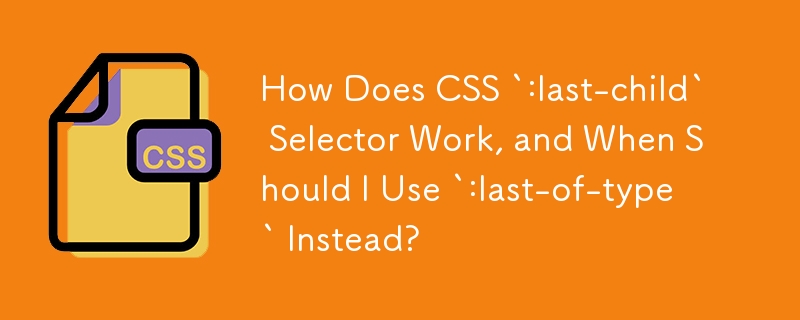 Web Front-end
Web Front-end
 CSS Tutorial
CSS Tutorial
 How Does CSS `:last-child` Selector Work, and When Should I Use `:last-of-type` Instead?
How Does CSS `:last-child` Selector Work, and When Should I Use `:last-of-type` Instead?
How Does CSS `:last-child` Selector Work, and When Should I Use `:last-of-type` Instead?

:last-child - An Element Selection Surprise
:last-child is a CSS selector that aims to target the last element of a parent container. It's a powerful tool when used appropriately, but it's important to grasp its limitations to avoid unexpected results.
As the documentation states, :last-child targets the "last child element of a parent." This crucial detail often goes unnoticed, leading to confusion. The selector won't work unless the targeted element is the absolute last one in its container.
Consider the following HTML example:
<ul>
<li class="complete">1</li>
<li class="complete">2</li>
<li>3</li>
<li>4</li>
</ul>Now, imagine we want to style only the last element with the "complete" class using :last-child.
li.complete:last-child {
background-color: yellow;
}Unfortunately, this won't work because "2" is not the last element in the list. Instead, "4" is the last element, which doesn't have the "complete" class.
To avoid such mishaps, it's important to remember that :last-child will only apply when the element is the very last one in its parent. If an element isn't the last, its background color won't change, as demonstrated in the above example.
In situations where the element we want to target may not necessarily be the last, it's better to use :last-of-type. This selector will match the last element of a particular type within a parent, regardless of whether it's the very last element overall.
Grasping the nuances of :last-child can empower you to harness its capabilities effectively. It's a valuable selector when targeting elements that are truly the last ones in their containers. However, if the last-of-type selector better suits your requirements, don't hesitate to use it instead.
The above is the detailed content of How Does CSS `:last-child` Selector Work, and When Should I Use `:last-of-type` Instead?. For more information, please follow other related articles on the PHP Chinese website!

Hot AI Tools

Undresser.AI Undress
AI-powered app for creating realistic nude photos

AI Clothes Remover
Online AI tool for removing clothes from photos.

Undress AI Tool
Undress images for free

Clothoff.io
AI clothes remover

Video Face Swap
Swap faces in any video effortlessly with our completely free AI face swap tool!

Hot Article

Hot Tools

Notepad++7.3.1
Easy-to-use and free code editor

SublimeText3 Chinese version
Chinese version, very easy to use

Zend Studio 13.0.1
Powerful PHP integrated development environment

Dreamweaver CS6
Visual web development tools

SublimeText3 Mac version
God-level code editing software (SublimeText3)

Hot Topics
 1662
1662
 14
14
 1419
1419
 52
52
 1313
1313
 25
25
 1262
1262
 29
29
 1235
1235
 24
24
 Google Fonts Variable Fonts
Apr 09, 2025 am 10:42 AM
Google Fonts Variable Fonts
Apr 09, 2025 am 10:42 AM
I see Google Fonts rolled out a new design (Tweet). Compared to the last big redesign, this feels much more iterative. I can barely tell the difference
 How to Create an Animated Countdown Timer With HTML, CSS and JavaScript
Apr 11, 2025 am 11:29 AM
How to Create an Animated Countdown Timer With HTML, CSS and JavaScript
Apr 11, 2025 am 11:29 AM
Have you ever needed a countdown timer on a project? For something like that, it might be natural to reach for a plugin, but it’s actually a lot more
 HTML Data Attributes Guide
Apr 11, 2025 am 11:50 AM
HTML Data Attributes Guide
Apr 11, 2025 am 11:50 AM
Everything you ever wanted to know about data attributes in HTML, CSS, and JavaScript.
 How We Created a Static Site That Generates Tartan Patterns in SVG
Apr 09, 2025 am 11:29 AM
How We Created a Static Site That Generates Tartan Patterns in SVG
Apr 09, 2025 am 11:29 AM
Tartan is a patterned cloth that’s typically associated with Scotland, particularly their fashionable kilts. On tartanify.com, we gathered over 5,000 tartan
 A Proof of Concept for Making Sass Faster
Apr 16, 2025 am 10:38 AM
A Proof of Concept for Making Sass Faster
Apr 16, 2025 am 10:38 AM
At the start of a new project, Sass compilation happens in the blink of an eye. This feels great, especially when it’s paired with Browsersync, which reloads
 PHP is A-OK for Templating
Apr 11, 2025 am 11:04 AM
PHP is A-OK for Templating
Apr 11, 2025 am 11:04 AM
PHP templating often gets a bad rap for facilitating subpar code — but that doesn't have to be the case. Let’s look at how PHP projects can enforce a basic
 How to Build Vue Components in a WordPress Theme
Apr 11, 2025 am 11:03 AM
How to Build Vue Components in a WordPress Theme
Apr 11, 2025 am 11:03 AM
The inline-template directive allows us to build rich Vue components as a progressive enhancement over existing WordPress markup.
 Programming Sass to Create Accessible Color Combinations
Apr 09, 2025 am 11:30 AM
Programming Sass to Create Accessible Color Combinations
Apr 09, 2025 am 11:30 AM
We are always looking to make the web more accessible. Color contrast is just math, so Sass can help cover edge cases that designers might have missed.



